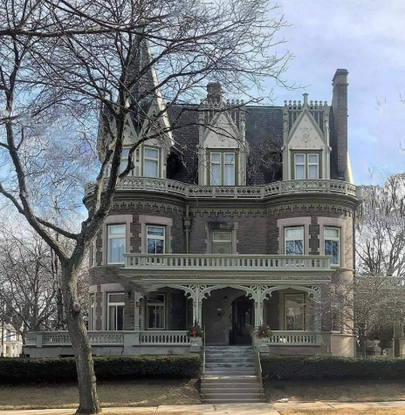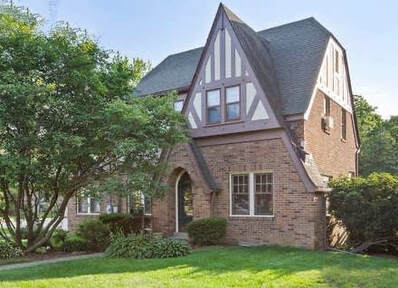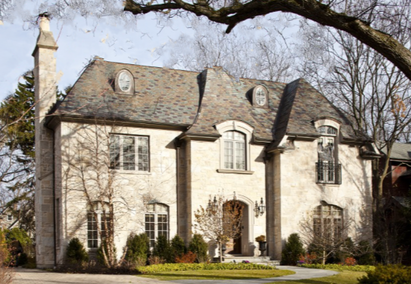
Chateauesque 1860 - 1910
The American version of the French château is now known as Chateauesque. This style home has many of the same characteristics as the Victorian Gothic Style and the Renaissance Revival House Style. Very expensive to build and therefore you are not going to find many residential houses (if any) other than those built for the very rich or landmark and civic purposes.
Where: Rare but cities of the North-Eastern states
Typical Features
The American version of the French château is now known as Chateauesque. This style home has many of the same characteristics as the Victorian Gothic Style and the Renaissance Revival House Style. Very expensive to build and therefore you are not going to find many residential houses (if any) other than those built for the very rich or landmark and civic purposes.
Where: Rare but cities of the North-Eastern states
Typical Features
- Highly ornamented roofline (spires, crosses, pinnacles)
- Ornamented windows and doors
- Tall, elaborate chimneys
- Steeply pitched hipped roof
- Multiple small roof parapeted dormers
- Balconies
- Towers and turrets
- Mansion-sized
- Ornate brackets
- Stone or masonry construction
- Roof ridges has ornamental metal cresting
- Lots of gothic ornamentation and tracing
- Windows divided by stone mullions
- Windows and doors often arched

Neoclassical Revivial 1895- 1950
This style is easily recognised by the very large, often central, full height porch with ornate classical columns. It is a standard text book Palladian or Corinthian classical style. It was somewhat popular until 1920 and then had another revival during the 1920s to 50s. If you take the earlier Georgian, Adam, Early Classical and Greek Revival and merge into one then you get Neoclassical. Although residential houses were built in this style it was mainly used for civic and bank buildings
Full-height porch with massive columns, Corinthian or Composite capitals, and large pediment; symmetrical facade.
Where: Throughout the States
Typical Features
This style is easily recognised by the very large, often central, full height porch with ornate classical columns. It is a standard text book Palladian or Corinthian classical style. It was somewhat popular until 1920 and then had another revival during the 1920s to 50s. If you take the earlier Georgian, Adam, Early Classical and Greek Revival and merge into one then you get Neoclassical. Although residential houses were built in this style it was mainly used for civic and bank buildings
Full-height porch with massive columns, Corinthian or Composite capitals, and large pediment; symmetrical facade.
Where: Throughout the States
Typical Features
- 1 - 2 1/2 storeys
- Symmetrical facade
- Brick, stucco, wood or vinyl exteriors
- Roof side-gabled or hipped
- Roof medium pitch
- Boxed eaves with slight overhang
- Triangular pediment over the front entrance
- Moulding or balustrades along roof line.
- Full-height porch with massive fluted columns, Corinthian or Composite capitals
- Windows have elaborate pediments
- Many variations on window design including paired, triple, bayed or arched
- Windows, double hung sashes
- Windows multiple lights upper and lower, or upper with a single pane below.
- Entrance contains an elaborate portico
- Porch has balustrades
- Some wings can be found

Tudor 1890- 1940
This style began in the late 19th century but became very popular in the 1920s growing suburbs of the 1920s. A version of Tudor came back into vogue in the late 20th century.
Where: Everywhere
Typical Features
This style began in the late 19th century but became very popular in the 1920s growing suburbs of the 1920s. A version of Tudor came back into vogue in the late 20th century.
Where: Everywhere
Typical Features
- Heavy over-elaborate chimneys
- Chimneys, often topped with decorative chimney pots
- Chimney pots round or hexagonal
- Chimneys often in front or side of house
- Steeply pitched side gable roof
- Prominent cross gables on front
- Gables overlap
- Variable eave heights
- Upper storey may overhang ground storey
- Porches sometimes at the far end but under the main house roof
- Decorative half-timbering give, Tudor style houses a Medieval flavour
- Often feature striking decorative timbers on vergeboards etc.
- Early examples wood cladding or shingles
- Mainly brick cladding
- Brick first storey sometimes
- Walls of stone cladding
- Stucco walls in a few
- Decorative half-timbering
- Tall, narrow windows
- Double hung casement windows with small (sometimes diamond)window panes
- Semi hexagonal two storey bays
- Cast stone trim and mullions around the windows

French Eclectic 1915-1945
The French Eclectic style is an amalgam of the many regional styles found across France. Adapted for town housing it also had a heavy influence of Beaux Arts, Chateauesque and Tudor styles
Where: Everywhere but not common
Typical Features
The French Eclectic style is an amalgam of the many regional styles found across France. Adapted for town housing it also had a heavy influence of Beaux Arts, Chateauesque and Tudor styles
Where: Everywhere but not common
Typical Features
- Tall elegant often symmetrical sometimes asymmetrical or towered buildings
- 1 -2 ½ storeys
- Façade mix brick and stone or other mixtures
- Sometimes side wings to symmetrical style
- Steeply pitched hipped roof
- Roof sometimes gabled
- Brick, stone or stucco exterior sometimes with pseudo half timbering
- Eaves often flared upwards at roof/wall junction
- Roof line varies
- Tile, slate, and shingle roof materials
- Balustraded porches, balconies and terraces
- Upper storeys often overhang
- Massive chimneys
- Quoins at corners of doors and windows
- Windows double hung sash or casement
- Windows and doors have shutters
- Windows break into roof line
- Tall, steeply pitched hipped roof
- Masonry wall cladding of stone or brick; often stuccoed
- Rounded Norman Towers are common
- Tower will likely house the main entrance
- Range of architectural detail including quoins, pediments, pilasters
- Wood is minimal
- French doors are used
- sometimes ribbon and wrap around building corner
